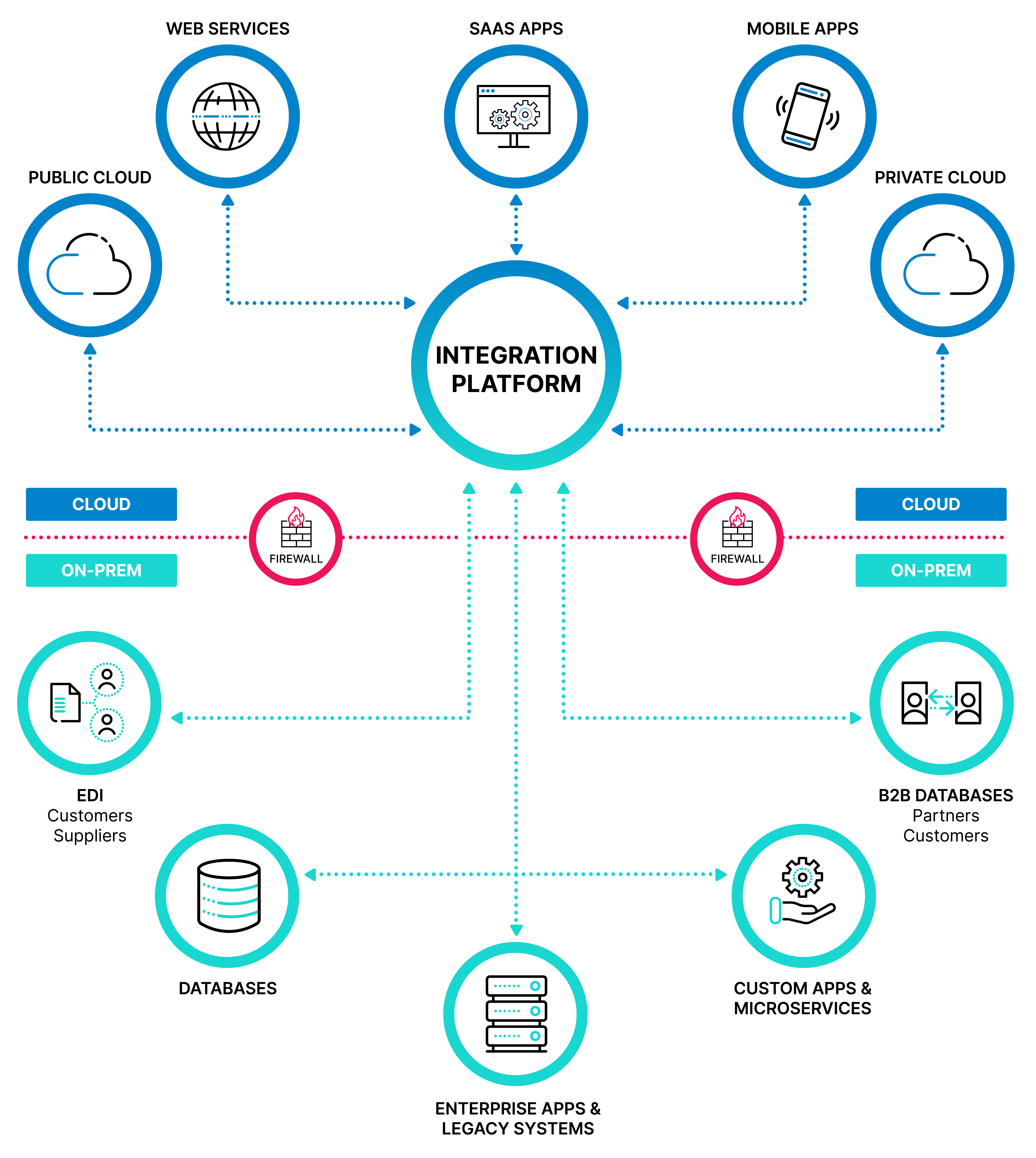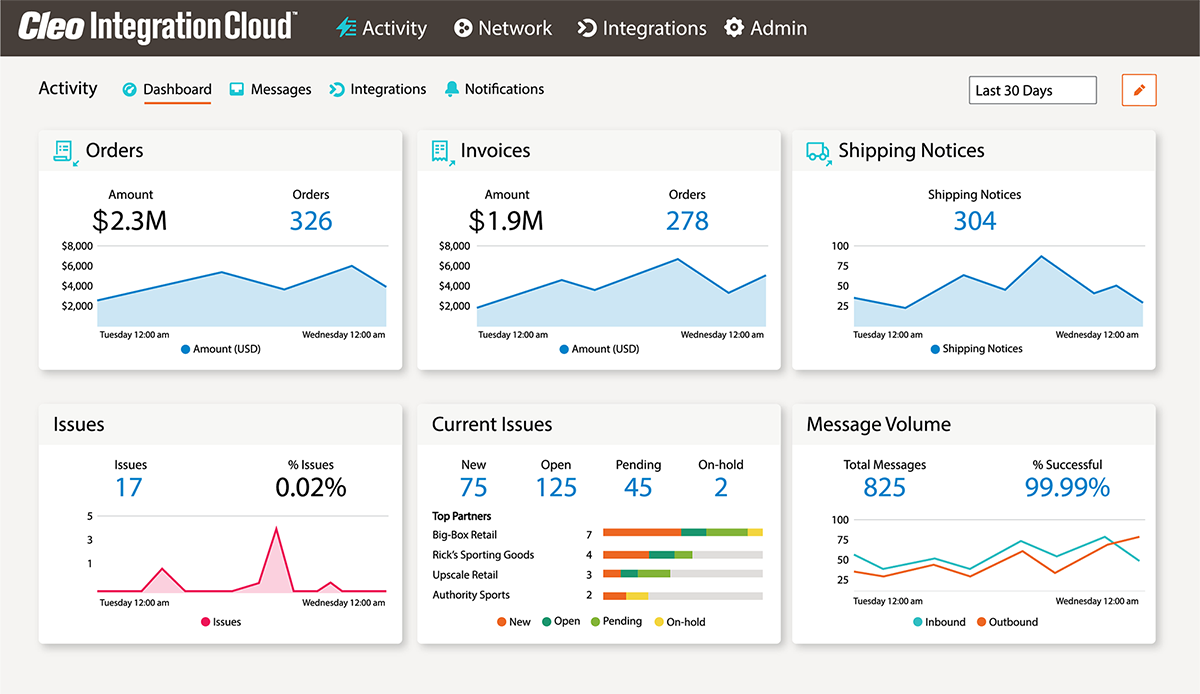6 Critical Ways an Integration Platform Drives Competition

Intro:
Imagine a restaurant with an overwhelming menu, where you could spend hours sifting through the drinks and appetizers, trying to find what you actually want.
While you could eventually find something you like, the process is time-consuming, tedious, and even frustrating.
Now, consider an integration platform as a curated menu, customized to your preferences, where all the options you need are available in one convenient place...
In the same way, an integration platform offers businesses these benefits by bringing together a variety of integrations in one central hub, providing flexibility and convenience to IT teams to adopt resources that enable them to deliver value to their customers.
The result is a cohesive and efficient system that enables businesses to meet and exceed their customers' expectations, creating greater outcomes than the sum of its parts.
A closer look at the integration platform, and 6 critical ways an integration platform drives competition:
→ What is an integration platform?
→ Why is an integration platform important?
→ What does an integration platform solution provide?
→ What about an ecosystem integration platform?
→ 6 crucial ways an integration platform makes business more competitive
→ What critical components should be considered in an integration platform?
→ Additional integration platform modern best practices
→ A similar option: iPaaS vs. integration platform
What is an integration platform?
An integration platform is a software solution that facilitates integration between different systems, applications, and technologies. It serves as a bridge between these disparate systems, enabling them to communicate and exchange information seamlessly. An integration platform is designed to streamline complex integration processes and eliminate the need for manual coding and customization. It distinguishes itself from enterprise integration by focusing on supply chain management.
It uses the system integration method to build an environment that adapts to the structure and control preferences of its users, giving businesses the ability to do the following:
Create, protect, and manage integration flows that connect various applications, systems, services, and data.
Allow for rapid API generation and lifecycle management to fulfill an array of hybrid integration requirements.
 |
While the idea of integrating disparate systems may seem daunting, integration platforms offer an efficient solution to manage and automate these processes.
Essentially, integration platforms act as a central hub that facilitates communication and integration between different components of an organization's technology ecosystem, enabling businesses to automate workflows, improve data accuracy, and streamline operations.
To learn more about hybrid integration platforms, read What is Hybrid Integration?
Why is an integration platform important?
Everyone is talking about integration platforms these days, and rightfully so. Highly competitive markets are searching for advanced, more cost-effective solutions that improve productivity, handle critical processes, and streamline operations. Even among all the buzz of "digital transformation" endeavors, the demand for new integrations is proving to be too much for organizations to handle. According to Gartner, "70% of digital transformation projects fail due to lack of integration quality."
An integration platform's ability to unify and organize data strategically is one of the most drawing aspects of an integration platform, which helps discover and coordinate vital data-insights. Businesses that utilize data to make choices are 58% more likely to surpass their revenue targets, according to a Forrester report.
The ability to transform cloud-based, on-premises applications and systems into a strategic, coordinated structure of software and hardware enables an organization to:
- Accelerate business operations and critical processes
- Improve data management efficiency
- Lower costs
- Enhance interactions with customers
What does an integration platform solution provide?
In the past, integration platform solutions were developed by linking together various capabilities within an organization, such as API management software, messaging tools, and Enterprise Service Bus (ESB) solutions from different vendors. This approach, however, can be expensive and complicated to implement in-house, and may not address all of an organization's needs. Additionally, certain features may be replicated across solutions from multiple vendors, while other essential capabilities may be overlooked. An organization may have implemented multiple API management solutions from different vendors, resulting in duplicated features such as security and access control
To address these challenges, modern integration platforms have emerged, which integrate all the necessary capabilities into a single, unified platform. These complete integration platforms not only streamline the integration process, but also facilitate communication between different types of integration. This can help organizations overcome some of the challenges associated with traditional integration approaches, such as high costs, complexity, and lack of scalability.
What about an ecosystem integration platform?
The ecosystem integration platform seems to be a rare breed among the iPaaS and integration markets however, word is getting out- and for good reason. Following the ecosystem integration approach; an "outside-in" method to orchestrating end-to-end integrations with a dynamic network of trading partners, applications, suppliers, customers, and marketplaces.
Integration platforms that are ecosystem-oriented strategically integrate a company's key revenue-generating business processes with those of its ecosystem trading partners. This is done by combining a suite of cloud, on-premise services, along with applicable B2B, EDI, API, application integration into one, agile solution. This form of integration platform not only prioritizes seamless internal integration, but external as well to create competitive agility from the single to multi-enterprise level.
6 crucial ways an integration platform makes business more competitive

Organizations can leverage this modern approach to multi-enterprise integration to achieve business outcomes and create value. By adopting this approach, organizations can achieve faster partner or application onboarding, optimize business processes, improve agility, and identify new digital revenue streams.
Here are six ways this type of integration platform improves operations:
1. Hybrid integration capabilities:
Ecosystem integration platforms accommodate for hybrid integration capabilities, enabling organizations to deploy and manage integrations both on-premise and in the cloud. This enables organizations to take advantage of the benefits of cloud technology while maintaining their existing on-premise systems.
2. Seamless internal/external integration:
Issues can jump on any given day, partner, integration, transaction, etc.. Developers being able to create and manage integrations seamlessly enables organizations to reduce downtime, connect their disparate systems and applications, and achieving a more integrated ecosystem.
3. Accelerate onboarding integrations:
An integration platform's ability to accelerate ecosystem onboarding processes is invaluable for fast-moving organizations. By automating the reuse of project templates, getting new partners integrated and transacting new business can take days, instead of weeks (or months). This means that organizations can quickly and easily create new integrations by building on existing templates, reducing the time and effort required to onboard new applications and systems.
4. End-to-end control, configuration, and visibility:
An ecosystem-driven integration platform provides real-time monitoring and management of all data exchanges moving through an organization's ecosystem. Organizations can identify and address issues quickly, minimizing the impact on business operations and ensuring that data is flowing securely and efficiently between systems.
5. Secure Data governance:
An ecosystem-driven integration platform provides all the necessary control and governance to ensure that data is being exchanged securely and in compliance with relevant regulations and policies. This reduces the risk of costly SLA chargebacks and mandate fines, enabling organizations to exchange data confidently and efficiently.
6. DevOps enablement:
An integration platform enables best-in-class infrastructure and advanced DevOps management, promoting a culture of innovation and continuous improvement. This enables organizations to deploy integrations quickly and easily, make changes to their ecosystem as needed to meet changing business requirements, and facilitate collaboration between development and operations teams.
What critical components should be considered in an integration platform?
Today's integration teams face the challenge of balancing traditional and modern integration styles to meet the demands of the digital age. When considering integration platforms, it's essential to have access to a mix of components that enable organizations to bridge the gap between legacy and new systems. Here are the most important components to consider:
1. Cloud Connected:
According to the 2023 State of Ecosystem Survey 31% of surveyed respondents claim to have difficulty integrating applications with cloud solutions. This could be a contributing factor as to why 75% of companies are looking to start migrating integration capabilities to the cloud in the next 12 months. As the cloud continues to grow in popularity, it will become increasingly important for businesses to deploy an integration solution that can easily integrate applications that are on-premise and in the cloud.
2. EDI & API Integration:
Businesses are increasingly using a mix of API integration and EDI that serve different but complementary purposes in business integrations. Globally, the API market is projected to grow to over $15 billion by 2028, while the EDI (electronic data interchange) market is expected to more than double by 2027. While APIs provide deeper context and enable real-time data access, EDI facilitates downstream processes and data orchestration.
With both technologies on the rise, APIs are becoming especially popular in modern integration, as they allow different systems to communicate with each other seamlessly. To keep up with the pace of innovation, companies must be able to manage EDI & API workflows. And of course, the creation, management, security, and sharing of APIs across environments quickly and easily. By doing so, companies can easily manage workflows and automate processes using a single integration-dedicated platform.
3. Data and Application Integration:
Siloed data is a significant hurdle for organizations trying to digitally transform. By synchronizing data across applications and copying it as needed, businesses can address a range of problems, including data formats and standards. Automation can further streamline the process and improve accuracy, ensuring that data is consistent across the organization.
4. Messaging and Event-driven Architecture:
Done correctly, event-driven architecture encompasses integrating with various applications and systems in real-time, based on events or triggers that occur within those systems. Combined with message alerting based on vital process-oriented issues. Standardizing data is crucial, but modern enterprises need to go beyond that to build engaging customer experiences and react to real-time data. Messaging and event-driven architecture allow organizations to securely exchange data across their ecosystem from cloud-based or on-premises applications. By doing so, businesses can develop agile systems that can quickly adapt to changing market conditions.
5. High-speed Data Transfer:
In today's data-rich environment, transferring large amounts of data quickly and reliably is crucial. With worldwide data creation expected to reach 163 zettabytes per year by 2025, companies must have the ability to send, share, stream, and sync large files at high speeds. By doing so, businesses can provide real-time responses to data, ensuring that they stay agile, and ahead of the competition.
Additional themes related to the use of integration platforms in modern best business practices:
1. Data Management:
One of the key challenges that businesses face today is how to manage and make sense of vast volumes of data. Integration platforms help organizations get a handle on their data by providing visibility into their data landscape and consolidating data from multiple sources. This, in turn, helps companies gain insights into their operations and make informed decisions based on the data.
2. Cloud-Based Integrations:
As organizations move their business to the cloud, integration platforms become increasingly important. Cloud-based integration platforms allow businesses to connect their on-premise systems with cloud-based applications and services seamlessly. The platform provides a centralized hub for managing data and workflows across different cloud environments, streamlining operations and encouraging collaboration.
3. Automation and Workflow Optimization:
By automating integration processes, integration platforms help reduce manual intervention and minimize the risk of human error. They also enable organizations to optimize workflows, create process efficiencies, and reduce cycle times. In this way, integration platforms help businesses operate more efficiently and cost-effectively, ultimately driving greater levels of productivity and profitability.
4. Scalability and Flexibility:
Integration platforms are designed to be highly scalable and flexible, allowing businesses to adapt and grow as their needs change. They seamlessly integrate with new systems and technologies, enable organizations to respond to new trends and market demands in real-time.
A Similar Option: iPaaS vs. Integration Platform
By combining multiple on-premises and cloud-based technologies through iPaaS, businesses can create a microservices architecture that provides greater flexibility, scalability, and agility. iPaaS provides the necessary tools and infrastructure to manage the integration of different systems, allowing businesses to create a seamless workflow across multiple platforms.
According to Gartner, an iPaaS, or Integration Platform as a Service is "a vendormanaged cloud service that enables end users to implement integrations between a variety of applications, services, and data sources." Very similar to a traditional integration platform however, users can customize iPaaS to a certain extent, they should not expect to be able to customize an iPaaS solution to meet all the requirements of their tech stack.
iPaaS Pros and Cons:
While iPaaS may seem like a more cost-effective and convenient option for businesses looking to integrate their systems and data, there are pros and cons to using this type of platform. One of the benefits of iPaaS is that it is cloud-based, thus making it quite flexible and scalable. It is also a relatively inexpensive option for businesses that need basic integration capabilities.
However, on the downside, iPaaS solutions tend to be more limited in terms of customization and control, which can be problematic for businesses with complex IT requirements.
Read more about iPaaS here What is iPaaS?
In conclusion, integration platforms are an essential tool for modern businesses. By enabling data consolidation, cloud-based integrations, workflow optimization, and scalability, integration platforms help businesses to operate more efficiently and cost-effectively. They also help businesses to adapt to changing technology trends, manage data more effectively, and improve the customer experience.
As businesses continue to face new challenges in an increasingly complex technology landscape, integration platforms offer a powerful solution for achieving success.
A Proven Integration Platform Solution: Cleo Integration Cloud®
An 'integration platform' literally means a platform that can connect |
If you're seeking an integration platform that meets the unique needs of your business, we recommend Cleo Integration Cloud.
With over 900+ years of combined experience with integration platform technologies, you'll be with trusted experts building a more focused integration platform category. With access to a comprehensive set of features that enable you to streamline your application workflows, including API management, application integration, and event-driven architecture.
However, we know there is no single universal method of integration that works for all. And as a result, you'll be able to use numerous integration styles inside Cleo's suite of integration platform solutions, and they'll all be configured to function together.
You'll get pre-built smart connectors as well as automation features such as deep-rooted integration visibility, automated notifications, and low-code tooling.
Learn how this works by watching a short demo video above. If you have questions about our solutions or your use cases, start a chat with an integration platform expert at sales@cleo.com or speak with someone right away at +1.815.282.7695.
An integration platform for the modern enterprise
To keep up with growing demand and a more competitive business landscape, today's modern enterprises are seeking new ways to provide a better customer experience. Digital transformation initiatives are some of the ways businesses are leveraging technology to modernize their environments and better compete.
From a new ticketing system in a company's support department to the full replacement of a home-grown warehouse management system, digital transformation initiatives span the entire enterprise and are advancing at a rapid clip.
But what can get lost in the enthusiasm of such initiatives is the proper integration of these applications and partner connections into the rest of the business processes.
The challenge lies in that the more these technologies are added to an enterprise's environment using one-off or custom-coded integrations, the more increasingly difficult it becomes for an IT department to maintain and scale.
Besides trying to manage all these connections to make sure these new initiatives run smoothly, the connections also can cause delays in onboarding and drastically slow down the speed of data and data exchanges.
With so many disparate integrations companies without clear, end-to-end data flows between all critical systems, applications, and partners risk losing the key visibility that ensures revenue-generating data is being handled securely and according to their customer SLAs.
Rapidly connect new partners and applications
So you know that you want to integrate new applications and partners, but perhaps you're unsure of how to do so today?
There are so many vendors out there selling connectivity in the form of a pure-play iPaaS or API-led integration solutions.
However, an ecosystem-driven integration platform, designed to comprehensively enable all your partners, systems, and applications in a process-focused way, simplifies B2B, cloud, and application integrations.
Such an integration platform streamlines configuration, offers robust B2B and application connectivity, and increases technology time-to-value to allow you to start doing business faster and focus on core business tasks.
The Benefits of Centralized Integration
A single integration platform provides an enterprise with many benefits for long-lasting and wide-reaching impact. For starters, the flexibility gained allows enterprises to better handle digital transformation initiatives and bring on new technologies, making it easy to connect and securely exchange information with any new ecosystem partner and agilely consume new capabilities.
Additionally, your business requirements are constantly evolving and the ability to use new protocols, transform data formats, and orchestrate your critical business processes is essential. A centralized integration platform means you can handle any and all data requirements from your trading partners, automatically route data where it needs to go, and gain end-to-end visibility and alerting capabilities to ensure you meet important customer SLAs.
Eliminate the complexity of end-to-end integration with a modern cloud integration platform to connect B2B flows, applications, and data across your entire ecosystem with Cleo Integration Cloud. This innovative digital platform is designed to connect, integrate, and analyze every end-to-end data flow between your ecosystem of customers, partners, suppliers, or external applications and your internal business systems.
Cleo Integration Cloud speeds the time to value by reducing the effort it takes enterprises to build and maintain data mapping and file transfers by automating the underlying integration processes. Additionally, it increases your ROI because it eliminates custom-coding and many of the manual processes that cause delays and expedites the time it to integrate applications with other B2B and EDI integration workflows.
An Integration Platform for IT Modernization
Download "The Common-Sense Guide to IT Modernization" to learn more about how to improve your business operations through IT modernization and how an ecosystem-driven integration platform enables that improvement through enterprise agility, insulates organizations from disruption, and support digital business transformation.
Download "The Common-Sense Guide to IT Modernization"

About Cleo
